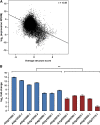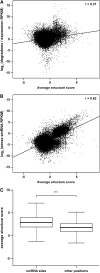Regulatory impact of RNA secondary structure across the Arabidopsis transcriptome
- PMID: 23150631
- PMCID: PMC3531838
- DOI: 10.1105/tpc.112.104232
Regulatory impact of RNA secondary structure across the Arabidopsis transcriptome
Abstract
The secondary structure of an RNA molecule plays an integral role in its maturation, regulation, and function. However, the global influence of this feature on plant gene expression is still largely unclear. Here, we use a high-throughput, sequencing-based, structure-mapping approach in conjunction with transcriptome-wide sequencing of rRNA-depleted (RNA sequencing), small RNA, and ribosome-bound RNA populations to investigate the impact of RNA secondary structure on gene expression regulation in Arabidopsis thaliana. From this analysis, we find that highly unpaired and paired RNAs are strongly correlated with euchromatic and heterochromatic epigenetic histone modifications, respectively, providing evidence that secondary structure is necessary for these RNA-mediated posttranscriptional regulatory pathways. Additionally, we uncover key structural patterns across protein-coding transcripts that indicate RNA folding demarcates regions of protein translation and likely affects microRNA-mediated regulation of mRNAs in this model plant. We further reveal that RNA folding is significantly anticorrelated with overall transcript abundance, which is often due to the increased propensity of highly structured mRNAs to be degraded and/or processed into small RNAs. Finally, we find that secondary structure affects mRNA translation, suggesting that this feature regulates plant gene expression at multiple levels. These findings provide a global assessment of RNA folding and its significant regulatory effects in a plant transcriptome.
Figures






References
Publication types
MeSH terms
Substances
Associated data
- Actions
- Actions
- Actions
- Actions
Grants and funding
LinkOut - more resources
Full Text Sources
Molecular Biology Databases

